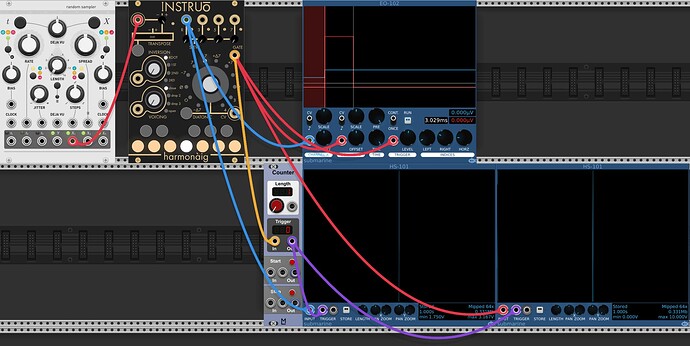A follow up, the email corresponcence with Jason Lim (copied with permission)
The quantiser in harmonaig is not set to the same CV's as VCV quant.
Here’s a video
https://drive.google.com/file/d/1xx3HhTOuTlLugfe1cQMZzTZ5FDP73agI/view?usp=sharing
Is this per design ?
I’m not really a user of your modules yet - I was just trying to help in this thread:
https://community.vcvrack.com/t/polyphonic-midi-issues-help/15804/21
Best regards
Jens Peter Nielsen.
Figured it out.
Perhaps you could change your code, to mimic https://library.vcvrack.com/Fundamental/Quantizer
https://drive.google.com/file/d/1y01x1HOskA89D5hvL7F7XgO-FNo_4RF5/view?usp=sharing
## VCV Rack harmonàig quantiser quirks
Jason Lim jason@instruomodular.com4 January 2022 at 19:01
Hi Jens,
Thanks for your enquiry.
I have taken a look through that VCV thread and your description.
I believe the “ghost” note artefacts that are printing to the midi track are not unique to the Harmonàig.
I don’t know whether this is specific to just VCV-VST within Ableton or if it’s a more universal occurrence when generating midi in this way.
My theory is a timing inaccuracy between the DAW operating sample rate/buffer size and the VCV sampling rate of virtual voltage signals (by the virtual CV to midi interface).
Ultimately I am unsure at which stage compensation would need to be patched in software to eliminate the artefacts.
From a hardware developers perspective I imagine it as being akin to the sampling of analogue voltage at an ADC; which is then quantised and mapped to a 7-bit midi note range.
If there is any amount of slew on the voltage one would expect there to be some quantisation error.
The timing of the new “voltage" quantised by the harmonàig, followed by it’s parallel generation of the 4 chord tone 1V/octave signals, followed by the sampling of these variable “voltages” for interpretation/quantisation to mini note values, is quite a number of processes!
Even in hardware, timing issues can arise in similar instances.
For example: an analogue sample&hold sampling a sequence from a digital sequencer, if both sequencer and S&H are clocked by the same signal.
The timing relies on the update rate of the sequencers DAC being quick enough in response to the clock signal which is simultaneously clocking an analogue S&H. The analogue aspect being essentially instantaneous while the DAC update rate will be dependent on processor speed.
Most likely the S&H in this instance will capture the previous step’s voltage amplitude and not the new step value.
This is not dissimilar to the example of a CV to midi modules sampling a variable voltage. The ADC is essentially a sample and hold defined by the processor’s clock rate and rate of the DAC sweep that measures the sample amplitude.
With regards to the Harmonàig’s input attenuverter range, the implementation is very much intentional.
I designed the Harmonàig with an input attenuverter which I purposefully allow to stretch a little past unity gain on its positive and negative extremes.
This is to allow for user compensation of any voltage drop or impedance mismatching between an incoming 1V/octave signal and the quantiser’s input.
The vague standards of eurorack are 100KΩ impedance on input jacks and a protective 1KΩ impedance on output jacks. This standard varies quite drastically across the wide range of available modules that can be combined in a eurorack system. Add to that the various stand alone CV sources such as USB powered midi keyboards sporting hardware CV outputs, and the consistency of voltage levels/signal impedances between devices is extremely variable!
I tend to advise that gain staging is almost as important in the CV domain as in the audio domain. Quantising already quantised voltages is perhaps the prime instance where it must be done well to achieve optimum results.
One of the key reasons I pursued the Instruō VCV plugin collection’s development is for use in educational settings.
I personally teach a sound design course here in Glasgow.
Allowing immediate access of the range of Instruō modules to my students for free is a hugely powerful resource. It has greatly extended accessibility 
I wanted to ensure an accurate representation of the modules in practice. This meant considering the many variables that need clarified when teaching modular functions/signal flow/sound design on analogue synths.
When teaching to patch on the virtual modules I wanted to ensure that the same practices and considerations would directly transfer over to an equivalent hardware system.
In the Harmonàig’s case, if the input attenuverter on the virtual model was always perfectly unity gain at the pot extremes it would be a mismatching experience to patching with it physically.
The real module has no floating point variable you can type in for the attenuverter… You simply tune it so that the octaves align.
Arguably the past-unity-gain-stretch on the attenuverter is a redundant consideration in a virtual environment as there is no voltage drop or impedance imbalance when multing a signal. But I think it would be teaching bad habits not to consider the eccentricities of an analogue instrument when the primary product behaves in that way.
It’s a bit like that daft group of school administrators in California proposing that for simplicity pi (π) should be rounded down to three…
This reason is also why I don’t use any of the polyphonic patching capabilities of VCV rack in any of the Instruō plugins.
I hope this makes sense and helps clarify the context.
Let me know if you have any other questions 
Happy new year and all the best for 2022.
Cheers!
Jason



